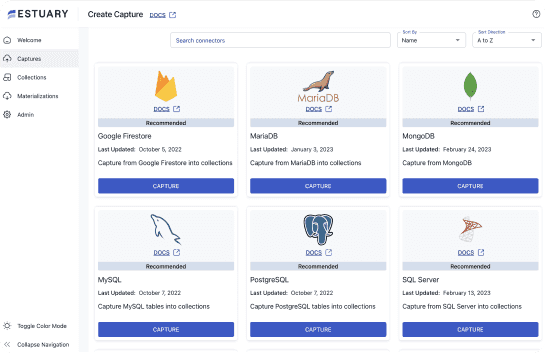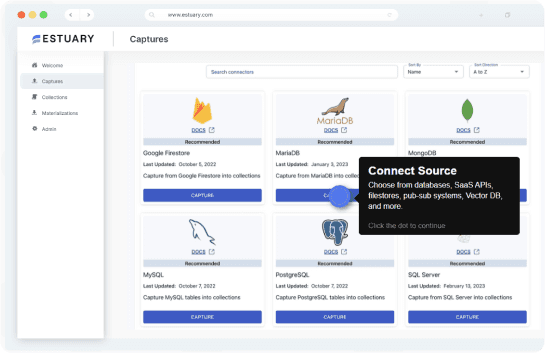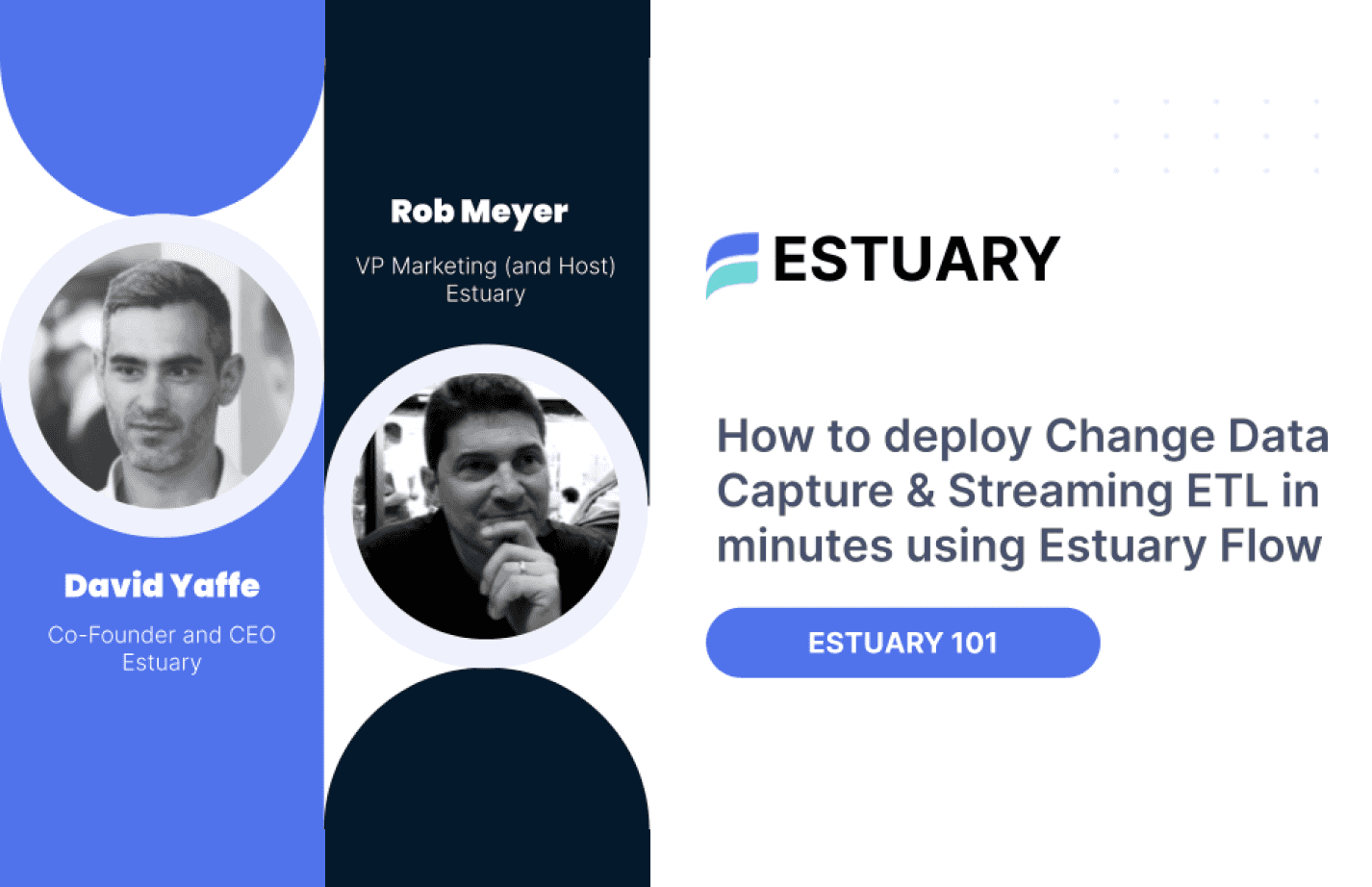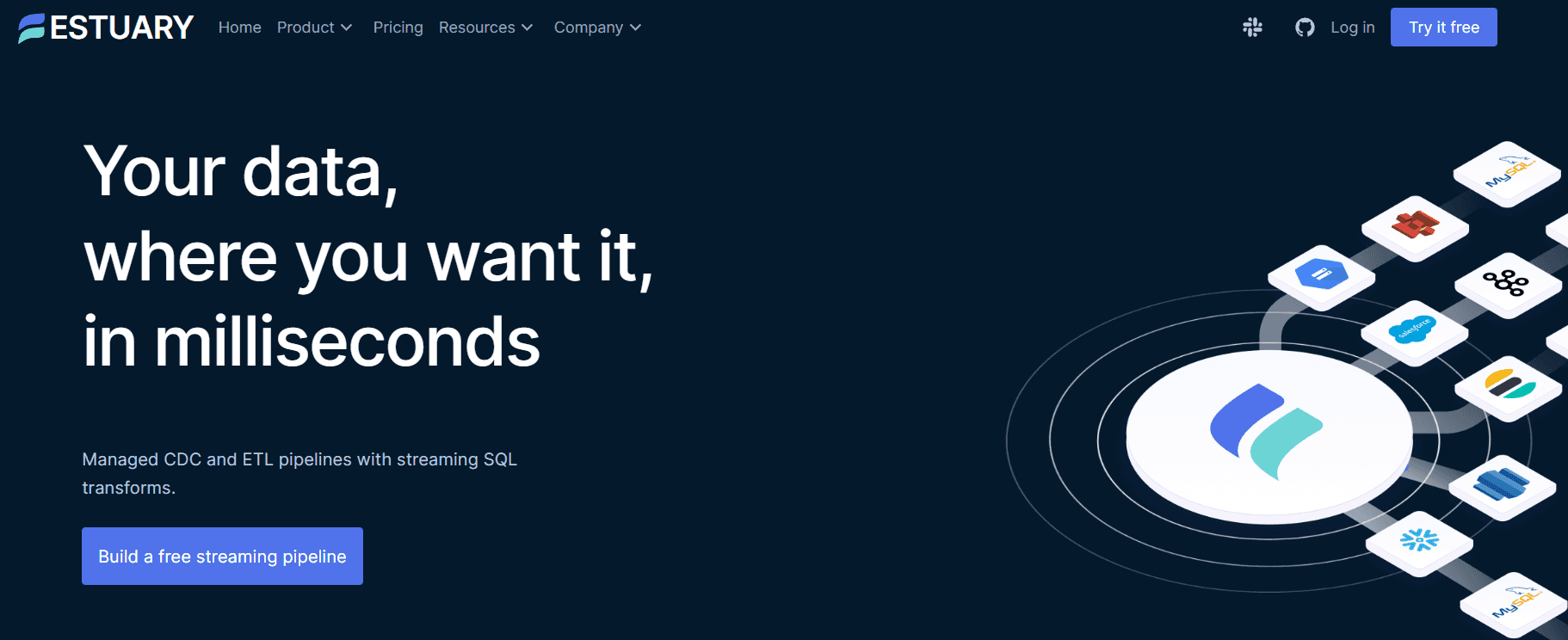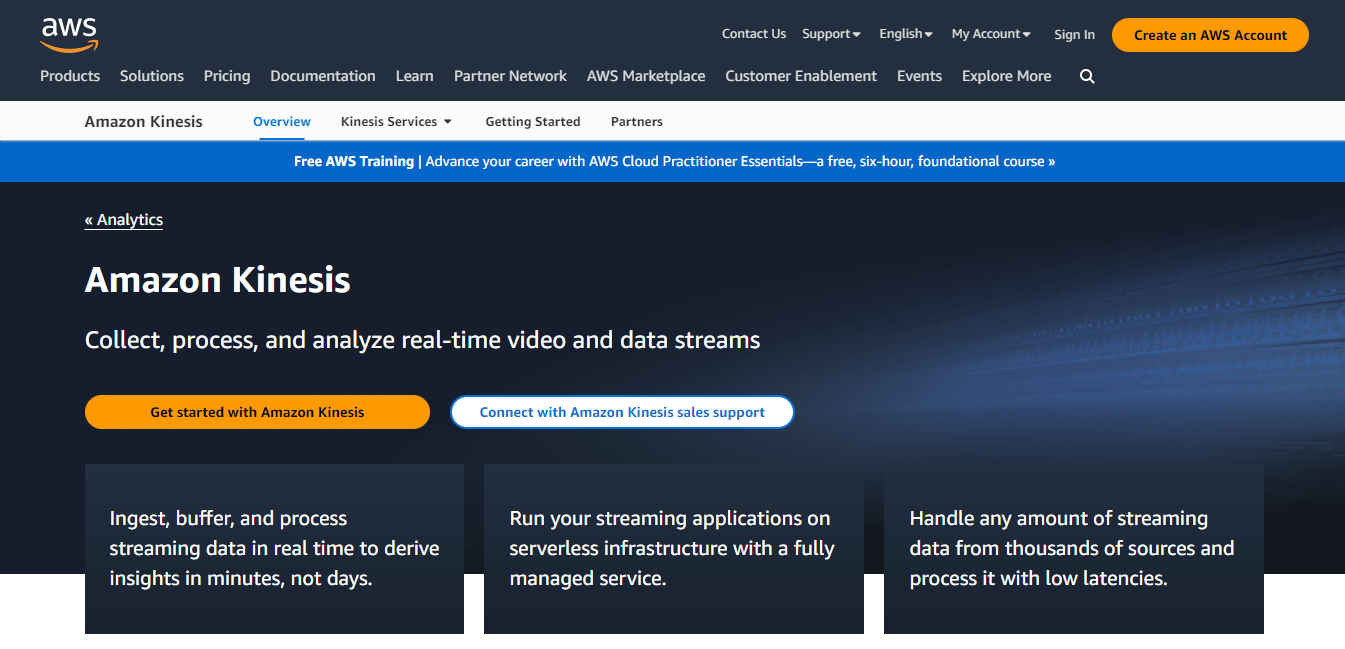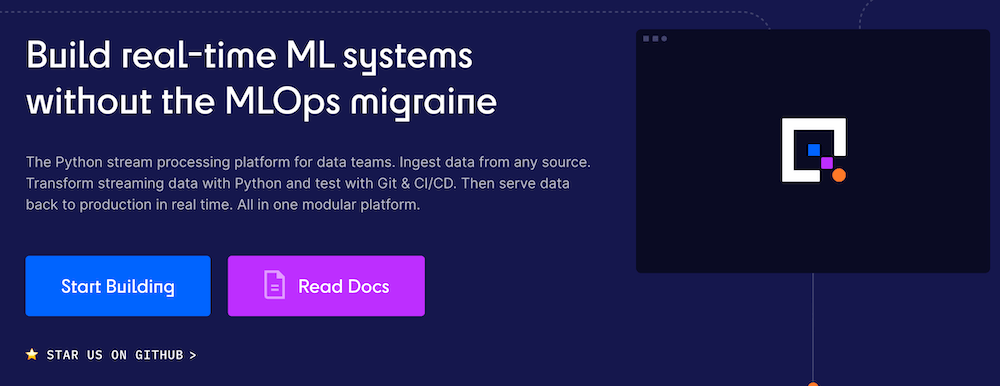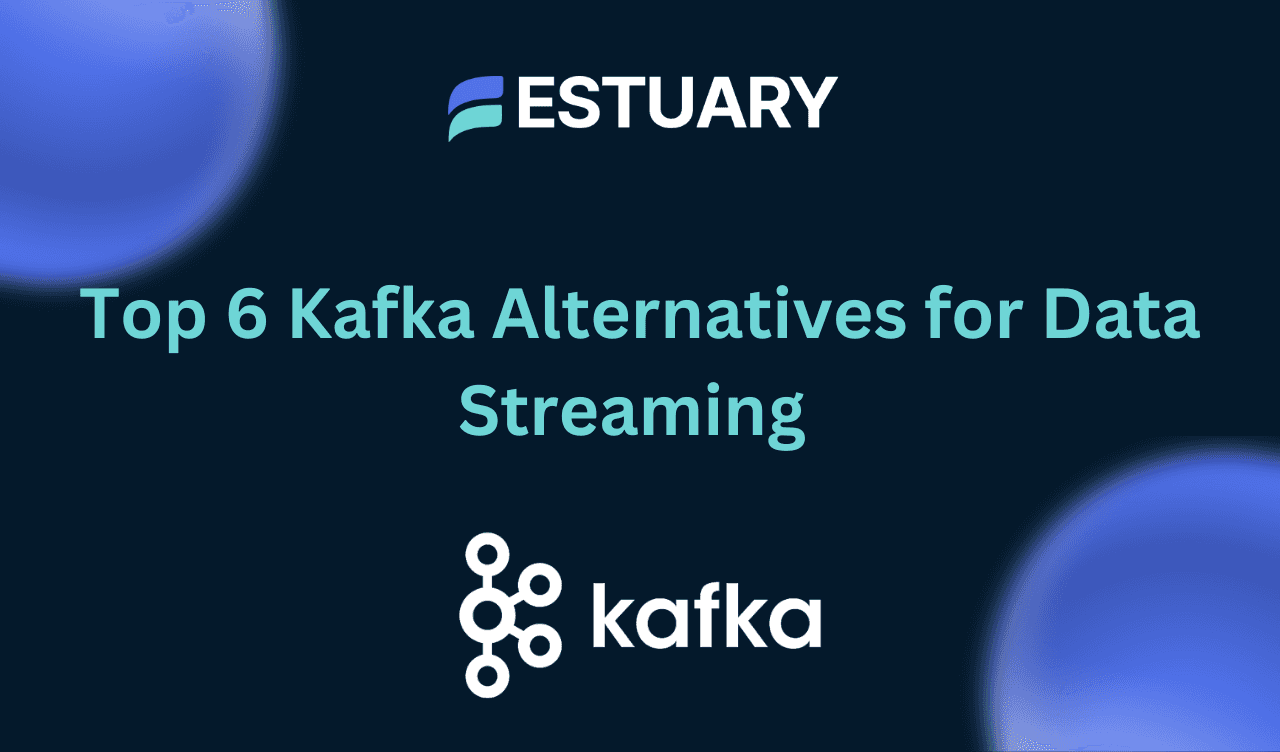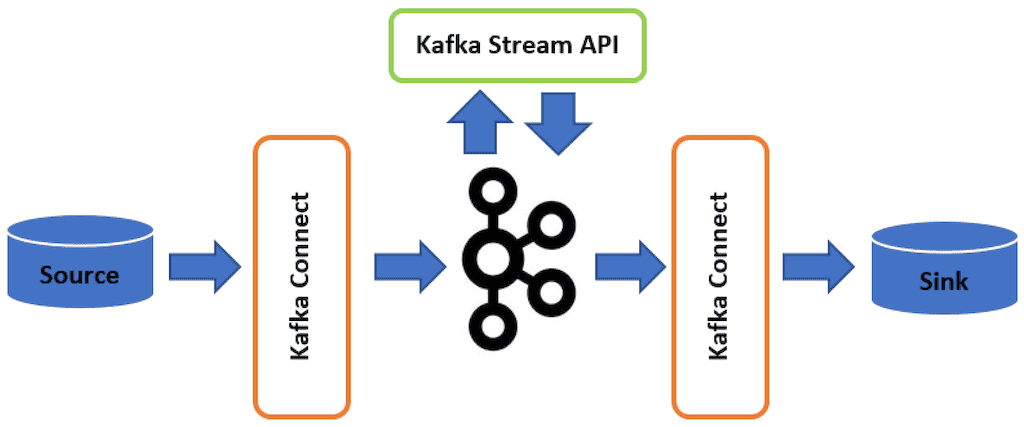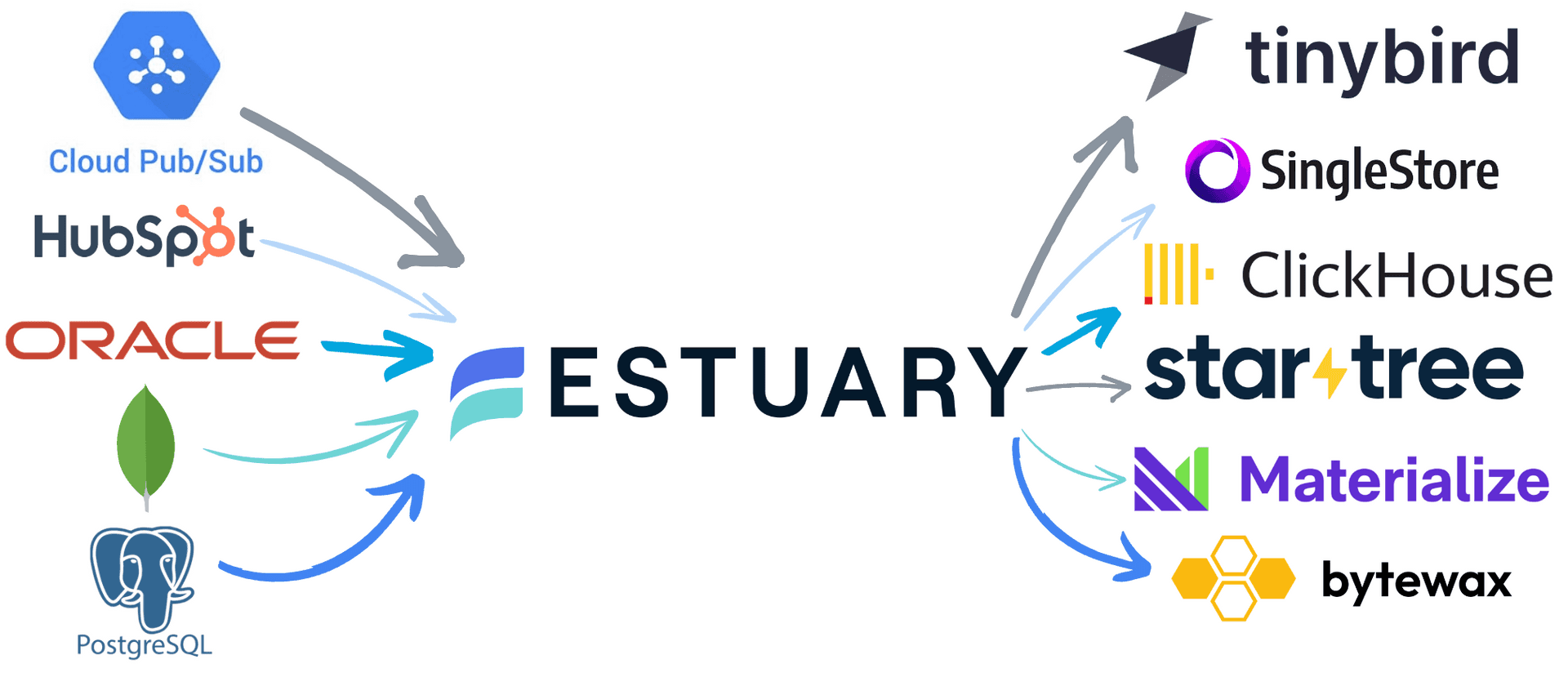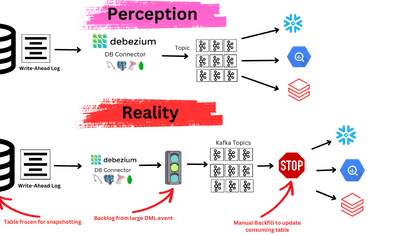
Introduction: Why Organizations Are Rethinking Confluent
Real-time data pipelines have become essential for modern data teams, driving everything from fraud detection and personalized recommendations to responsive dashboards and operational agility.
While Confluent Kafka helped mainstream event streaming by offering a managed experience on top of Apache Kafka, many organizations in 2025 are reevaluating their stack. High costs, operational overhead, and limited flexibility are prompting teams to explore leaner, more scalable alternatives.
Today, robust alternatives like Estuary Flow, AWS Kinesis, and Azure Event Hubs offer powerful real-time streaming with less complexity. Meanwhile, open-source platforms like Apache Pulsar, Redpanda, Apache Samza, and modern cloud-native tools like Quix are redefining what’s possible in stream processing.
This guide compares the top Confluent Kafka alternatives in 2025, helping you evaluate the right fit for your use case — from CDC pipelines and analytics to high-throughput messaging and real-time ML workflows.
What is Confluent?
Confluent is a commercial data streaming platform built on top of Apache Kafka. It simplifies the deployment, scaling, and monitoring of Kafka-based pipelines for processing real-time event data at scale.
As a managed service, Confluent offers enterprise-grade features such as:
- Kafka as a Service: A fully managed, cloud-native version of Apache Kafka.
- Prebuilt Connectors: Integration with popular systems like PostgreSQL, MongoDB, Snowflake, and Elasticsearch.
- Stream Processing Tools: Native support for stream transformations via ksqlDB and Kafka Streams.
- Confluent Control Center: A GUI-based tool for managing cluster health, latency metrics, and throughput.
- Schema Registry: Built-in schema validation for Apache Avro and Protobuf.
Confluent appeals to large-scale engineering teams who need Kafka’s streaming power with managed infrastructure and additional tooling.
But despite its strengths, Confluent can introduce pain points — especially around cost, scalability flexibility, and vendor lock-in. It also comes with Kafka’s inherent complexity, which makes onboarding non-expert teams difficult.
This is where modern alternatives like Estuary Flow come into play — offering a simpler, faster, and more flexible approach to building real-time pipelines across diverse environments, without the steep learning curve of Kafka.
Limitations of Confluent Kafka
While Confluent Kafka offers a robust platform for real-time data streaming, several limitations have been identified in 2025 that organizations should consider:
1. Scalability Challenges
Despite advancements like Tiered Storage and Self-Balancing Clusters, Confluent Kafka can still face scalability issues, especially in dynamic environments. Organizations have reported that simply adding resources doesn't always resolve bottlenecks, and optimization strategies are essential for effective scaling.
2. Operational Complexity
Managing Confluent Kafka clusters requires significant expertise. Tasks such as partition rebalancing, configuration tuning, and monitoring can be complex and time-consuming, potentially leading to increased operational overhead.
3. Cost Considerations
Confluent's pricing model, based on Confluent Units for Kafka (CKUs), can become expensive as data volumes grow. Organizations have noted that costs can escalate rapidly, making it challenging to predict expenses accurately.
4. Limited Flexibility in Configuration
Confluent Kafka does not support out-of-band configuration modifications. Any manual changes to individual tasks can be overridden by the system, limiting flexibility and potentially leading to configuration drift.
5. Storage Management Constraints
While Tiered Storage offers benefits, Confluent Kafka still requires careful planning for disk usage. Adjusting volume requirements after deployment is not straightforward, and improper management can lead to issues like disk space exhaustion.
6. Security Vulnerabilities
Recent security advisories have highlighted vulnerabilities in Confluent Kafka's authentication mechanisms, such as the incorrect implementation of the SCRAM algorithm, which could potentially lead to security breaches.
Considering these limitations, organizations are exploring alternatives that offer greater scalability, flexibility, and cost-effectiveness. Platforms like Estuary Flow provide real-time data streaming solutions with dynamic scaling, simplified operations, and transparent pricing, making them a compelling choice for modern data infrastructure needs.
Top Alternative to Confluent Kafka in 2025
In 2025, teams are moving beyond Confluent Kafka to platforms that offer real-time streaming with lower costs, easier scaling, and built-in CDC — all without the Kafka overhead.
Estuary Flow
Estuary Flow isn’t just a Confluent Kafka alternative — it’s a unified platform for real-time data capture, transformation, and delivery.
Built on Gazette, Flow offers the performance of append-only logs like Kafka, but extends far beyond. It simplifies the entire data engineering workflow with native support for Change Data Capture (CDC), streaming joins, schema enforcement, and real-time transformations — all in a visual or code-first interface.
Key Features of Estuary Flow
- Built-In CDC & Streaming Connectors: Capture from databases like Oracle, Postgres, SQL Server, MongoDB, MySQL, and stream to warehouses like Snowflake, BigQuery, Databricks, or Lakehouse formats like Iceberg & Delta. All in real time, no extra tooling required.
- Schema-Aware Streaming: Define schemas once. Flow enforces them across all collections and auto-evolves them as your source data changes, minimizing breakage.
- No-Code & Code-Friendly: Use Flow’s intuitive UI or YAML-based specs via flowctl. SQL-based derivations enable stateless transformations directly in the pipeline.
- Real-Time Integrations with dbt Cloud & Snowflake: Trigger dbt jobs on new data arrival. Load into Snowflake using Snowpipe Streaming for <5s latency. All handled natively.
- Bring Your Own Cloud (BYOC): Flow supports private deployments with VPC Peering or PrivateLink. Retain full control over infrastructure and storage while Estuary handles orchestration.
- Highly Scalable & Cost-Efficient: Pipelines scale dynamically — no downtime, no over-provisioning. Pricing is based on data volume, not compute hours like Confluent.
- Kafka Compatibility with Dekaf: Estuary also includes Dekaf, a Kafka API compatibility layer that exposes Flow collections as Kafka topics. This means existing Kafka-based tools and consumers can work with Estuary pipelines — no changes required.
Why Choose Estuary Flow Over Confluent Kafka?
Feature | Estuary Flow | Confluent Kafka |
| Real-Time CDC from DBs | Native support | Requires 3rd-party tools |
| Schema Evolution | Built-in | Manual or external tooling |
| UI for Setup | Fully visual | Limited (Control Center is complex) |
| Cloud Storage Integration | BYOC supported | Proprietary and rigid |
| Streaming + Batch | Unified | Kafka only |
| Pricing | Volume-based (transparent) | Per hour, can scale unexpectedly |
Sample Use Cases
- Replace complex Kafka + Debezium setups with a one-stop CDC pipeline from Oracle/Postgres to BigQuery or Snowflake.
- Real-time analytics for marketing, finance, IoT, logistics, and more.
- Sync data across systems like Salesforce, Shopify, MongoDB, MySQL, and Redshift — in real time, with guaranteed consistency.
Try Estuary Flow Free - Whether you’re scaling beyond Kafka, replacing Fivetran, or building your first streaming data pipeline, Estuary Flow makes it easy, fast, and future-proof.
Start your free trial or talk to our team to see how Flow can modernize your real-time architecture.
AWS Kinesis
Amazon Kinesis is AWS’s real-time data streaming platform, designed to ingest, buffer, and process massive streams of data. It is tightly integrated with the AWS ecosystem, making it a strong choice for organizations already invested in AWS infrastructure.
In 2025, Kinesis continues to be a viable Confluent Kafka alternative, particularly for use cases like real-time analytics, telemetry ingestion, and event-driven architectures.
Key Features
- Fully Managed & Serverless: Kinesis Data Streams requires no server management, and you can scale up or down using on-demand mode or shards.
- AWS Native Integration: Seamlessly connects with AWS services like Lambda, Redshift, S3, Glue, and CloudWatch.
- Multiple Ingestion Services: Includes Kinesis Data Streams, Kinesis Firehose (for delivery to S3/Redshift), and Kinesis Data Analytics (for SQL-based stream processing).
- Low Latency: Real-time streaming with latency as low as 70ms for downstream consumers.
- Durable & Fault-Tolerant: Data is replicated across three Availability Zones and can be retained for up to 365 days.
Potential Drawbacks
- Vendor Lock-in: Deeply tied to AWS; migrating to another platform later may be complex.
- Shard Management Complexity: Manual shard scaling can still be error-prone, unless using on-demand mode.
- Limited Ecosystem vs Kafka: Does not offer the breadth of integrations and open-source tooling available in Kafka's ecosystem.
Apache Pulsar
Apache Pulsar is an open-source, distributed messaging and streaming platform designed for scalability, low latency, and multi-tenancy. Its architecture separates compute and storage layers, allowing for independent scaling and efficient resource utilization.
Key Features of Apache Pulsar
- Multi-Tenancy: Supports multiple tenants with resource isolation, enabling efficient sharing of a single Pulsar cluster among different teams or applications.
- Geo-Replication: Built-in support for replicating messages across multiple data centers, ensuring high availability and disaster recovery.
- Tiered Storage: Allows older data to be offloaded to cheaper storage solutions like cloud object stores, facilitating long-term data retention without impacting performance.
- Flexible Messaging Models: Supports both publish-subscribe and message queue semantics, catering to a wide range of use cases.
- Schema Registry: Provides a built-in schema registry for data validation and compatibility checks, ensuring data integrity across producers and consumers.
Apache Pulsar's advanced features make it a strong contender for organizations seeking a flexible, scalable, and cloud-native streaming solution. Its multi-tenancy, geo-replication, and tiered storage capabilities offer advantages over traditional Kafka deployments, especially in complex, multi-team environments.
Redpanda
Redpanda is a high-performance, Kafka-compatible streaming platform built in C++ for low-latency workloads. Unlike Kafka, Redpanda does not rely on ZooKeeper or JVM, which simplifies deployment and reduces operational complexity.
In 2025, Redpanda continues to gain traction among companies seeking a fast, resource-efficient alternative to Kafka that supports both real-time and historical data workloads.
Key Features
- No ZooKeeper or JVM: Redpanda has always operated without ZooKeeper, unlike legacy Kafka setups. While Kafka has moved to KRaft to eliminate ZooKeeper, Redpanda was designed this way from the start.
- Kafka API Compatibility: Redpanda is wire-compatible with Kafka, which means Kafka tools and clients work out of the box.
- Built for Performance: Its C++ engine offers lower latency and higher throughput than JVM-based Kafka in many use cases.
- Tiered Storage: Redpanda supports tiered object storage for cost-effective data retention and efficient replay.
- Simplified Operations: Single binary deployment and minimal tuning make it DevOps-friendly.
Potential Drawbacks
- Smaller Ecosystem: While Kafka’s ecosystem is vast, Redpanda’s connector and tooling landscape is still growing.
- Less Open Source: Redpanda Core is source-available, but some enterprise features are gated behind a commercial license.
Azure Event Hubs
Azure Event Hubs is Microsoft’s fully managed, real-time data ingestion service built for large-scale streaming. It offers native Apache Kafka protocol support, enabling Kafka clients to write to Event Hubs without changing application code.
In 2025, Azure Event Hubs has matured into a strong alternative for teams already using Azure and seeking deep integration with Microsoft's analytics and security ecosystem.
Key Features
- Kafka-Compatible Endpoint: Event Hubs provides a Kafka interface, allowing users to migrate from Kafka to Event Hubs without rewriting their producers or consumers.
- Fully Managed: No infrastructure or broker management required; Microsoft handles scaling, patching, and maintenance.
- Scalable Throughput: With Auto-Inflate enabled, Event Hubs dynamically increases throughput units (TUs) based on load.
- Enterprise-Grade Security: Integrates with Azure AD, RBAC, and private networking options like VNET integration and Private Link.
- Long Data Retention: Retain streaming data for up to 90 days (or more in Premium tier), useful for audit, replay, and backfill use cases.
Potential Drawbacks
- Vendor Lock-in: Best suited for teams deeply embedded in the Azure ecosystem.
- Less Control Over Internals: As a fully managed PaaS offering, low-level tuning isn’t possible like it is with self-managed Kafka.
- Kafka Feature Gaps: Some Kafka ecosystem tools may not be fully compatible despite the protocol support.
Apache Samza
Apache Samza is a distributed stream processing framework developed by LinkedIn and now maintained by the Apache Software Foundation. It's designed for real-time, asynchronous computation and integrates seamlessly with Apache Kafka for messaging. Samza excels in stateful processing, fault tolerance, and scalability, making it suitable for complex, real-time data processing applications.
Key Features of Apache Samza
- Stateful Processing: Samza efficiently manages and maintains state using local storage and changelog streams, ensuring consistency and fault tolerance.
- Fault Tolerance: It provides robust fault tolerance by checkpointing state and replaying messages from Kafka in case of failures.
- Scalability: Samza is designed to scale horizontally, handling large volumes of data across distributed systems.
- Flexible Deployment: It supports deployment on YARN, Kubernetes, or as a standalone library, offering flexibility in various environments.
- Integration with Kafka: Samza integrates tightly with Apache Kafka, leveraging Kafka's capabilities for messaging and storage.
Drawbacks of Apache Samza
While Samza is powerful for real-time processing, it comes with limitations that might impact adoption:
- Steeper Learning Curve: Samza's architecture and APIs can be more complex to grasp compared to newer, more user-friendly platforms like Estuary Flow or Kinesis.
- Limited Ecosystem: Samza doesn't have as broad a connector ecosystem or cloud-native integration as some modern alternatives, making it harder to plug into diverse data sources or destinations out-of-the-box.
- Operational Complexity: Though flexible in deployment, managing Samza with systems like YARN or Kubernetes can require significant DevOps expertise, especially for scaling and monitoring.
Quix
Quix is a fully-managed platform that works with the Quix Streams library. Tooled out for ML training from the get-go, the Quix platform allows you to easily separate resource consumption by running stream processing tasks as serverless functions.
To create and deploy a service or a job in the Quix platform, developers just need to specify their dependencies in a requirements file and Quix will install them automatically for you.
Here’s how Quix squares up with Confluent Kafka:
- Architecture: Since Quix is a unified platform, data processing, sourcing, and analyzing are all done in one place. You can use the Quix Streams library as an external source to send data from Python-based data producers. You can even deploy connectors within the Quix platform to ingest data from external APIs like IoT message hubs and WebSockets.
- Monitoring: Quix has a set of monitoring tools like deployment logs, build logs, and infrastructure monitoring. It also has a monitoring API that’s primarily meant for internal use.
- Learning Curve: Since there is no domain-specific language that developers need to learn, they can get started right away. With Quix, developers have a gentle learning curve since it lacks infrastructural obstacles. A singular focus on Python as a first-class citizen further makes it easier to comprehend for Python developers.
- Ecosystem: The Quix Streams library was open-sourced in 2023, therefore it doesn’t quite enjoy the extensive tooling that Confluent Kafka does.
Drawbacks
- Relatively New Ecosystem: Quix’s open-source library (Quix Streams) and ecosystem are still maturing compared to more established alternatives.
- Limited Language Flexibility: Strong Python support, but lacks built-in multi-language flexibility compared to platforms like Apache Flink or Kafka Streams.
Confluent Kafka Alternatives Comparison Table (2025)
Before deciding on a streaming platform, it's important to compare the key capabilities, limitations, and use cases of each option. The following table offers a side-by-side comparison of the top Confluent Kafka alternatives in 2025 to help you choose the best fit for your real-time data needs.
Tool | Streaming Type | Open Source | Managed Option | Schema Evolution | Ideal For | Notable Drawbacks |
| Estuary Flow | Real-time + Batch | ✅ (BYOL) | ✅ (Cloud, BYOC) | ✅ Auto-evolving | Real-time CDC pipelines | Limited OSS documentation; still growing awareness |
| AWS Kinesis | Real-time | ❌ | ✅ | ❌ Manual | AWS-native real-time streaming | Limited connectors, shard limits |
| Apache Pulsar | Real-time | ✅ | ✅ via StreamNative | Partial via schema registry | Multi-tenant & geo-replication use cases | Steep learning curve, complex ops |
| Redpanda | Real-time (Kafka API-compatible) | ✅ Community | ✅ (Redpanda Console) | ❌ Manual or via tooling | High-performance low-latency use cases | Proprietary enterprise features |
| Azure Event Hubs | Real-time | ❌ | ✅ | ❌ Manual | Microsoft cloud-native streaming | Kafka compatibility layer may limit features |
| Apache Samza | Near real-time | ✅ | ❌ | ❌ Manual | Java-based apps on YARN | Outdated and less active community |
| Quix | Real-time w/ Python focus | ❌ (partial OSS) | ✅ | ✅ JSON-focused | Data scientists using Python pipelines | Young ecosystem, fewer enterprise integrations |
Conclusion: Which Confluent Kafka Alternative Is Right for You?
Choosing the right alternative to Confluent Kafka depends on your organization’s priorities—whether it’s ease of use, low latency, advanced transformations, or native cloud integration.
If you’re seeking a fully managed, real-time streaming platform that supports both Change Data Capture (CDC) and schema evolution out of the box, Estuary Flow is a top contender. It lets you build robust streaming pipelines without the operational burden of maintaining Kafka infrastructure.
- Estuary’s modern architecture is built to unify streaming + batch
- Auto-scaling, real-time transformations, and schema awareness
- Seamless integrations with databases, data lakes, and analytics tools
Get started with Estuary Flow and move data effortlessly, securely, and in real time — without writing brittle scripts or managing brokers.
FAQs
1. What are the best alternatives to Confluent Kafka in 2025?
2. Is there a real-time data streaming platform better than Kafka?
3. What’s the difference between Confluent and Apache Kafka?

About the author
With over 15 years in data engineering, a seasoned expert in driving growth for early-stage data companies, focusing on strategies that attract customers and users. Extensive writing provides insights to help companies scale efficiently and effectively in an evolving data landscape.

